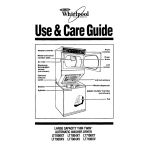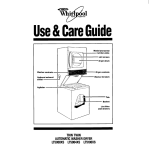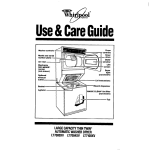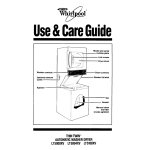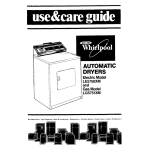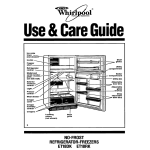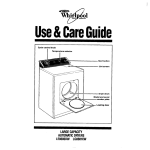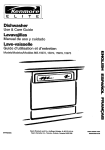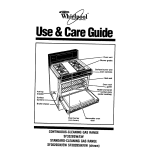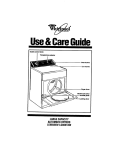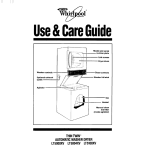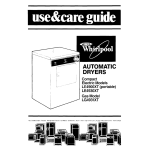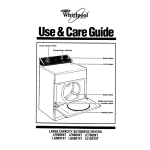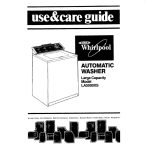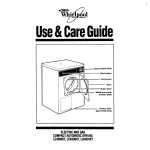Download Whirlpool LT71OOXT Operating instructions
Transcript
T%kl 46^ HOflE Applmces 01 Use& CareGuide Washer Dryer controls controls Dryer A-..Electronic DRY-MISER’@ sensor (not shown) exhaust Lid instructions Bleach dispenser MAGIC CLEAN@ lint filter (not shown) Tub LARGECAPACITYTHINTWIN' AUTOMATICWASHERDRYER LT7OOOXT LT7004XT LT71OOXT LT7OOOxV LT7004XV LT71OOXV Contents Page Important Safety Instructions., Additional safety instructions and your responsibilities Loading Suggestions Loading Load sizes and water levels Washer Operating Instructions Starting your washer What happens in each cycle Other Operating Instructions Rinse and spin Drain and spin Soak cycle Pre-washcycle ,,_.__._..___ Liquid bleach dispenser Liquid fabric softener dispenser MAGIC CLEAN” lint filter Dryer Operating Instructions Starting your dryer The automatic cycles Timed drying cycle Using damp dry Using TUMBLE PRESS Fluff air cycle End-of-cycle signal Gentle heat Lint Removal. If You Need Service or Assistance. Whirlpool Thin Twin” Warranty.................... 3 4 5 5 6-7 7-l 0 11 11 11 11-12 12 NOTE: Do not remove any permanent instruction labels inside the dryer. You should wipe out the dryer drum wrth a damp cloth before using to remove dust from storing or shipping. Thank you for buying a Whirlpool appliance. Please complete and mail the Owner Registration Card provided with this product. Then complete the form below. Have this information ready if you need service or call with a question. l Copy model and serial numbers from plate (next to dryer drum opening) and the purchase date from the sales slip. l Keep this book, the Laundry Guide and the sales slip in a handy place. 12 12 Model Number 13 14 15 15 15 15 15 15 16-l 7 Serial Number Purchase Service Company Phone Number FOR YOUR SAFETY If you smell gas: 1. Open windows. 2. Don’t touch electrical switches. 3. ;z$eguish any open . 4. Immediately call your gas supplier. 18-l 9 20 01989 Whirlpool Corporation If your Thin Twin has a Consumer Buy Guide label, remove it. It will be easier to remove before the washer is used. To remove any remaining glue: l Rub briskly with thumb to make a ball, then remove. or l Soak area with liquid hand dishwashing detergent before removing glue as described above. Do not use sharp Instruments, rubbing alcohol, flammable fluids or abrasive cleaners. These can damage the finish. See “Important Safety Instructions” on page 3. 2 Date J 1 FOR YOUR SAFETY Do not store or use gasoline or other flammable vapors and liquids in the vicinity of this or any other appliance. The fumes can create a fire hazard or explosion. 1 ImportantSafetyInstructions To reduce the risk of fire, electric shock, or injury to persons when using your Thin Twin, follow basic precautions, including the following: l l l l l l l l Read all instructions before using the Thin Twin. NEVER wash or dry items cleaned, washed, soaked in or spotted with wax, paint, gasoline or flammable fluids in the Thin Twin. The fumes can create a FIRE HAZARD or EXPLOSION. ALWAYS hand launder and air dry fabrics containing these materials. NEVER allow children to operate, play with, or crawl inside the Thin Twin. Close supervision of children is necessary when the Thin Twin is used near children. When discarding an old Thin Twin, ALWAYS remove the lid and door to prevent accidental entrapment. NEVER reach into the Thin Twin until all the motion stops. If the lid is opened while the washer basket is spinning, the basket will automaticaky stop in a few seconds. DO NOT install or store Thin Twin where it will be exposed to the weather. DO NOT tamper with the controls. You are responsible for making sure that your Thin Twin is installed, repaired and parts replaced by a qualified person. NEVER use or store flammable fluids (dry-cleaning solvents, gasoline, kerosene) in or near your Thin Twin. Do not add flammable fluids to the wash water. These substances give off vapors that can create a FIRE HAZARD or EXPLOSION. l Use only dryer fabric softeners specifically labeled as not being harmful to the dryer. l FIRE HAZARD and DAMAGE to materials can result from: - drying rubber, rubber-like and heat sensitive materials with heat. - allowing lint to build-up inside the dryer or exhaust system cleaning should be done by a qualified person. l Clean lint screen before or after each load. l If hot water has not been used recently (usually 2 weeks or longer), hydrogen gases may build up in the water heater and the hot water pipes. HYDROGEN GAS IS EXPLOSIVE. To prevent injury or damage, before using your washer, turn on all hot water faucets and allow water to run for several minutes. This will allow gases to escape. DO NOT smoke or use any open flame near the faucet while it is open. l DO NOT let dust, paper, rags, lint, chemicals, etc. pile up, around or under the Thin Twin. l The Thin Twin must be electrically grounded. See the Installation Instructions. - SAVE THESE INSTRUCTIONS l 3 Important Continued Safety Instructions Additional safety instructions and your responsibilities l l l l l l ALWAYS shut off the gas valve before leaving on vacation. ALWAYS unplug the power supply cord before attempting to service the Thin Twin. Shut off GAS VALVE if yours is a gas dryer. DO NOT machine wash or dry glass fiber materials. Small particles can stick to fabrics laundered in following loads and cause skin irritation. HAZARDOUS FUMES can be formed if chlorine bleach is used in the same wash as ammonia or acids such as vinegar or rust remover. ALWAYS store detergent, laundry aids and other materials in a cool, dry place where children can’t reach them - in a locked cabinet if possible. ALWAYS read and follow instructions on packages of detergent and laundry aids - especially warnings and precautions. NEVER operate the Thin Twin if.. - it is not working right. - it is damaged. - parts are missing. - all panels are not in place. l You are responsible for making sure that your Thin Twin: - is properly maintained. - is properly installed and leveled in a well ventilated room on a floor that can support the weight.’ - is located in an area where the temperature is above 45°F (7.2%) because the dryer will not operate properly at cold temperatures and freezing temperatures can damage the washer. - is connected to the proper electrical supply, outlet, water supply, plumbing fixtures, drain and dryer exhausting system.’ - is not installed against drapes or curtains.* - is used only for jobs normally expected of home automatic Thin Twins. *Refer to the Installation Instructions for complete information. l When not washing, keep both water faucets turned off. This takes the pressure off the water inlet valve and hoses. LoadingSuggestions Loading MIXED LOAD 2 double or 1 king size sheet 4 pillowcases 6 T-shirts 6 pair shorts 2 shirts 2 blouses 6 handkerchiefs PERMANENT PRESS 1 double sheet 1 tablecloth 1 dress 1 blouse 2 slacks 3 shirts 2 pillowcases HEAVY WORK CLOTHES 2 pair pants 3 shirts 1 coverall 3 pair jeans KNITS 2 slacks 2 tops 4 blouses 4 shirts 2 dresses TOWELS 8 bath towels 8 hand towels 10 wash cloths 1 bathmat DELICATES 2 camisoles 4 slips 4 panties 2 bras 2 nighties Load sizes and water levels n For best cleaning results, the load must be able to move freely in the water. Too big a load or too little water can cause wear or tearing of load items. (13.4 galsJ50.8 L)’ (9.5 galsJ36.0 L)’ *Approximate fill with load. NOTE: Do not overload washer. WasherOperatingInstructions The drawings in this book may vary slightly from your Thin Twin model. They are designed to show the different features of all the models covered by this book. NOTE: Your model may not include all the features shown. Starting your washer Be sure to measure and add detergent, then place a sorted load in the washer before starting it. 1. Select a load size Position the Load Size Selector at the setting that describes the size of load you want to wash. l The selector can be set anywhere on or between EX SMALL (a few small items) and EX LARGE (a full load). l To change the water level after the washer has started to fill, turn the selector to RESET then to the desired water level. NOTE: For best washing results, items should move freely in the washer. Do not overload the washer or choose a water level that is too low for your wash load. For best results with permanent press clothes, use the EX LARGE water level. Reduce wash time when using EX SMALL or SMALL water level settings. Loads with only a few small Items need less wash time for best results. l 2. Select water temperature l Match the water temperature to the type of fabric and soils being washed. l The top temperature is the wash selection and the bottom temperature is the rinse selection. NOTE: Use warm wash water with the PERMANENT PRESS or KNITS GENTLE Cycles. For heavily soiled permanent press or knit clothes, pre-wash or pre-soak before washing in warm water. ALWAYS use cold rinse water for permanent press fabrics. 3. Select cycle and wash time Start the washer l Push the Cycle Control Knob and turn it to the right. l Stop on the number or indicator mark in the wash cycle you want. These indicate the minutes of wash time. l Start the washer by pulling out the Cycle Control Knob. The washer will fill to the selected water level with the selected wash temperature. After filling, the washer will agitate for the selected number of minutes. l To stop the washer at any time, push in the Cycle Control Knob. To restart the washer, pull out the Cycle Control Knob. What happens in each cycle Each cycle has different agitation and spin speeds designed for different kinds of fabrics. Numbers on the dial in each cycle are the minutes of wash agitation time. When the Cycle Control Knob is set to a number and pulled out, the washer fills before agitation and timing starts. After agitation starts, the knob turns clockwise until it points to OFF and the cycle ends. Gentle Wash System For better fabric care in the REGULAR and PERMANENT PRESS Cycles, the agitation speed is reduced during the last few minutes of wash agitation time. NOTE: You may hear the sound of water spraying during the spin parts of some cycles. In some cycles, water is sprayed on the spinning load to help with the rinsing. The washer will pause briefly throughout each cycle. These pauses are normal. They allow for the reversing of the motor, normal washer operation and the cool-down portion of the PERMANENT PRESS Cycle. Washer Operating Continued Regular Instructions Cycle A cycle for sturdily constructed fabrics that are moderately to heavily soiled. to Selected Level Permanent Press Cycle A cycle designed for lightly to rnoderately soiled permanent press and some synthetic fabrics. The cool-down rinse helps keep wrinkles from setting into these items. to Selected Level 6 Minutes Low Speed High Speed, Spray Rinses Low Speed, Spray Rinses NOTE: Always use cold rinse water for permanent press fabrics. Knits Gentle Cycle A cycle that gently washes and spins moderately to lightly soiled delicate items and washable knits. Soak and Pre-Wash Cycles Brief periods of agitation and soak time help remove heavy soils and certain stains that need extra pretreatment. Use recommended amount of detergent or presoak additive. The SOAK Cycle should always be followed by a wash cycle. to Selected Level to Selected Level 4-2 Minutes Low Speed 2 Minutes High Speed 8 Minutes No Agitation 4 Minutes High Speed RINSE Low Speed DRAIN No Agitation NOTE: The pre-wash setting starts the washer at the second wash period. Special care is needed when soaking or pre-washing laundry. See the Laundry Guide for proper use of this cycle. Alndicates that machine is pausing for a brief soak period. Washer Operating Continued Super Instructions Wash Cycle Use for washing heavily soiled loads thal require maximum soil removal. Double the amount of detergent recommended when using the SUPER WASH Cycle. to Selected Level 4 Minutes High Speed After the partial drain, the washer automatically refills and goes into the REGULAR Cycle. Be sure to use enough detergent for the double wash. OtherOperatingInstructions Rinse and spin When using extra detergent for heavily soiled clothes, or washing special-care items, you may want an extra rinse and spin. 1. Push Cycle Control Knob in. 2. Turn clockwise to one of the dots on the dial, as illustrated. 3. Pull Cycle Control Knob out. The washer will fill to selected level, agitate 2-4 minutes depending on the cycle selected, drain and spin. Soak cycle For best results, use warm water for soaking stained laundry. Hot water can set stains. 1. Use recommended amount of presoak product or detergent. 2. Push Cycle Control Knob in. 3. Turn clockwise to point to the number next to SOAK. 4. Pull the Cycle Control Knob out. The washer will start. 5. When the cycle is over, add detergent for the next selected wash cycle. The SOAK Cycle should always be followed by a wash cycle. NOTE: See the Laundry Guide for additional soaking information. Pre-wash cycle For best results, use warm water for pre-washing stained laundry. Hot water can set stains. 11 Other Operating Continued Instructions 1. Use recommended amount of additional pre-washing information Liquid bleach dispenser Always measure bleach. Do not guess. Never use more than 1 cup (250ml) for a full load. Use less with lower water level settings. Follow directions on bottle for safe use. Use a cup with a pouring spout to avoid spilling. 1. Load the washer first. 2. Pour measured bleach carefully into dispenser. Do not let bleach splash, drip or run down into washer basket. Undiluted bleach will damage any fabric it touches. 3. Start the washer, Bleach will be diluted automatically during the wash part of the cycle. Liquid fabric softener dispenser A liquid fabric softener dispenser is available for the washer. To order, write to: Whirlpool Corporation Attention: Customer Service Dept. 1900 Whirlpool Dnve LaPorte, IN 46305 and order the LT7000XT fabric softener dispenser, Part No. 3350634. MAGICCLEAN’lint filter The lint filter In your washer cleans itself. Collected lint is drained away with the wash and rinse water. If your washer drains into a tub, remove any lint collected In the drain or strainer. 12 DryerOperatingInstructions Starting your dryer Before starting your dryer, be sure laundry is sorted and loaded properly. Make sure the door is tightly closed. 1. Select a cycle and time by turning the Cycle Control Knob either way to point to the cycle and time setting you want. 2. Set the Temperature Selector on or between any desired temperature settings. 3. Push the Start Button to start the set drying cycle and time settings. 4. To stop and restart the dryer: l Open the door or turn the Cycle Control Knob to OFF to stop the dryer. l Close the door, select a cycle (if necessary) and push the Start Button to restart the dryer. 5. To change the setting at any time, turn the Cycle Control Knob either way to point to a new time setting. The Cycle Control Knob should point to an OFF area when the dryer is not in use. If the dryer is stopped before the cycle is finished, turn the Cycle Control Knob to an OFF area. 13 Dryer Operating Continued Instructions The automatic cycles The automatic cycles allow you to select the degree of dryness you prefer for the clothes being dried. The electronic DRY-MISER’ control is an electronic sensor that determines the amount of moisture in the clothes. The dryer automatically shuts off when the proper dryness is reached. until the clothes load is almost dry, or the Cool-Down portion of the cycle has been reached. After the Cool-Down portion is complete, the Cycle Control Knob automatically moves to an OFF area and tumbling stops. NOTE: Overdrying can cause shrinkage, static cling and damage to some fabrics. 14 TIMED DRYINGcycle Use the TIMED DRYING Cycle for any load you want to dry by time. l Turn the Cycle Control Knob to the number of minutes you want. l The last 8 minutes of this cycle are without heat. This helps make the load easier to handle. FLUFFAIR cycle Fire Hazard Do not dry plastic or rubber items with heat. Use AIR setting, or line dry. Failure to do so could result in fire or damaged items. Using DAMPDRY Use this setting to dry damp items that do not require an entire drying cycle, or to dry items to damp level. (Two examples are heavy cottons, such as jeans, which you do not want to become stiff, or cotton clothes which are easier to press when damp.) 1. Set the Cycle Control Knob on DAMP DRY in the PERMANENT PRESS Cycle. 2. Push the Start Button. The dryer tumbles the load with heat for 22 minutes, then without heat for 8 minutes. Using TUMBLEPRESS@ The TUMBLE PRESS setting removes wrinkles from clothing that has been packed in a suitcase or closet, and from items not removed from the dryer at the end of a cycle. The load will tumble in heated air for 12 minutes. The heat shuts off and the dryer continues to tumble for 8 minutes. For best results, put only a few items at a time in this cycle. As soon as the dryer stops, put items on hangers or fold them. The dryer does not heat when the Cycle Control Knob is set in FLUFF AIR. This cycle can be used to fluff or air dry bedding, plastic tablecloths, foam rubber pillows, stuffed toys, sneakers, etc. 1. Turn the Cycle Control Knob to the number of minutes you want in FLUFF AIR. 2. Push the Start Button. End-of-cyclesignal The dryer sounds a signal to let you know when the cycle is finished. The signal cannot be turned off and is not adjustable. The signal is helpful when you are drying permanent press, synthetic and other items that should be taken out as soon as the dryer stops. Gentle heat The dryer automatically reduces the heat during the last few minutes of each drying cycle, before cool-down. This helps prevent overdrying. 15 Dryer Operating Continued Instructions Selecting a cycle SUGGESTED CYCLE TYPE OF LOAD Cottons and linens EXTRA HEAVY - Bedspreads, matlress pads, qurlts HEAVYWEIGHT -Towels, jeans, corduroys, work clothes MEDIUMWEIGHT - Sheets, pillowcases, cotton, underwear, diapers LIGHTWEIGHT - Batistes, organdies, lingerie Permanent press, synthetics and blends HEAVYWEIGHT-Work clothes, jackets, raincoats MEDIUMWEIGHTShirts, play clothes, sheets, slacks LIGHTWEIGHTLingerie, blouses, dresses Knits HEAVYWEIGHTCottons, rayons, blends, T-shirts, slacks, shirts LIGHTWEIGHT - Synthetic (polyester, acrylic, etc.) and blends, linqerie. blouses, dresses Delicate fabrics Sheer cur-tarns (2 or 3 panels), gauze, lace, etc. Rubber, plastic, heat sensitive fabrics FOAM RUBBER - Pillows, bras, stuffed toys PLASTIC - Shower curtains, tablecloths RUBBER-BACKED RUGS OLEFIN, POLYPROPYLENE, SHEER NYLON AUTOMATIC REGULAR AUTOMATIC PERMANENT PRESS AUTOMATIC PERMANENT PRESS AUTOMATIC PERMANENT PRESS FLUFF AIR 20 minutes 20 minutes 20 minutes 15-20 minutes LintRemoval Clean the lint screen before each load. The lint screen is located at the front of the dryer door opening. To clean: 1. Lift screen straight up. 2.ROLL lint off the screen with your fingers. DO NOT rinse or wash the screen. 3.Replace the screen. 16 Clean lint gathered in screen area. Periodically remove the dryer lint screen and vacuum the opening. Use the long, thin attachment (crevice tool) on your vacuum cleaner. Fire Hazard Do not run the dryer with the lint screen loose, damaged, blocked or missing. Doing so can cause overheating, damage and be a fire hazard. Clean lint gathered inside the dryer. Lint can gather inside the dryer and create a FIRE HAZARD. This lint should be removed at least every 2 to 3 years, or more often, depending on dryer usage. Heat’lnlet I Then&stat duct Electrical SUPPlY I Motor Electrical Shock and Personal Injury Hazard l Unplug the power supply cord or turn off the electrical power before lint removal. l Do not put hands inside the cabinet. l More than one person is required to lift, tilt or move the washer/dryer because of its weight and size. Failure to do so could result in electrical shock, injury or damage. Cleaning should be done only by a qualified person. 1, Unplug unit from electrical supply or turn off electrical power. 2. Remove back panel from dryer. 3. Avoid touching wires and thermostats 4. Remove lint from boxed-in area with a soft brush or vacuum cleaner. 5. Replace back panel, reconnect and level the Thin Twin. 17 If YouNeedServiceOrAssistance... We suggest you follow these steps: 1. Before calling for assistance... Performance problems often result from little things you can find and fix yourself without tools of any kind. If your washer does not fill: Is the power supply cord plugged into a live circuit with the proper voltage? l Are both water faucets open? l Have you checked your home’s main fuses or circuit breaker box? l Are the water supply hoses kinked? l Is the Cycle Control Knob set and pulled out? l If your Is the l Is the a live l Have fuses l washer does not spin: lid closed? power supply cord plugged into circuit with the proper voltage? you checked your home’s main or circuit breaker box? If your washer drains at the wrong time: l The drain hose should be at least 28 inches above the floor and secured. l The drain hose should not fit tightly in the drain pipe. l Make sure that the Cycle Control Knob is pointing to a number in the cycle. Make sure the drain hose is higher than the water level in the washer. If it isn’t... l The washer may seem to be draining during wash and rinse cycles. l Water can siphon out. (See Installation Instructions.) 18 If your washer stops during a cycle: l Remember, the washer pauses briefly at different times in each cycle. These pauses are normal. If your dryer does not run: . Is the power supply plugged into a live circuit with the proper voltage? . Is the door closed tightly? l Did you push the START Button? . Have you checked your home’s main fuses or circuit breaker box? If your dryer does not heat: The FLUFF AIR setting is without heat. l The last few minutes of heated cycle settings are without heat. l An electric dryer uses a circuit breaker or 2 fuses. If one fuse is blown, the dryer may run, but not heat. l If drying time seems too long: Is the gas turned on? If not, turn the Cycle Control Knob to OFF. Turn on gas. Wait 5 minutes. Reset controls and start. l Is the lint screen clean? See page 16 of this book for cleaning instructions. l Is exhaust system clean? Cleaning should be done by a qualified person. l 2. If you need assistance:.. Call Whirlpool COOL-LINE” service assistance telephone number. Dial free from anywhere in the U.S.: I-800-253-1301 and talk with one of our trained consultants. The consultant can instruct you in how to obtain satisfactory operation from your appliance or, if service is necessary, recommend a qualified service company in your area. 3. If you need service’... Whirlpool has a zi,fl 01% ~~~~~~~e~twork senvrce Whirlpool”” service companies. Whirlpool service technicians are trained to fulfill the product warranty and provide after-warranty service, anywhere in the United States. To locate the authorized Whirlpool service company in your area, call our COOL-LINE@ service assistance telephone number (see Step 2) or look in your telephone directory Yellow Pages under: 3 SER”,(‘ECoMPmlES XYISERVICE CO \23MAPLE W-9999 4. If you have a problem’... Call our COOL-LINE service assistance telephone number (see Step 2) and talk with one of our consultants, or if you prefer, write to: Mr. Donald Skinner Director of Consumer Relations Whirlpool Corporation 2000 M-63 Benton Harbor, Ml 49022 Please include a daytime phone number in your correspondence. 5. If you need FSP’ replacement parts’... FSP is a registered trademark of Whirlpool Corporation for quality parts. Look for this symbol of quality whenever you need a replacement part for your Whirlpool appliance. FSP replacement parts WIII fit right and work right, because they are made to the same exacting specifications used to build every new Whirlpool appliance. To locate FSP replacement parts in your area, refer to Step 3 or call the Whrrlpool COOL-LINE service assistance number in Slep 2. 6. If you are not satisfied with how the problem was solved’... l Contact the Major Appliance Consumer Action Panel (MACAP). MACAP is a group of independent consumer experts that voices consumer views at the highest levels of the major appliance industry. l Contact MACAP only when the dealer, authorized servicer or Whirlpool have failed to resolve your problem. Major Appliance Consumer Action Panel 20 North Wacker Drive Chicago, IL 60606 l MACAP will in turn inform us of your action. ‘When requesting assistance, please provide: model number, serial number, date of purchase, and a complete description of the problem. This information is needed in order to better respond to your request. Whirlpool”’ ThinTwin”Warranty l-r002 LENGTH OF WARRANTY WHIRLPOOL WILL PAY FOR FULL ONE-YEAR WARRANTY From Date of Purchase FSP@ replacement parts and repair labor to correct defects in materials (including top and lid rust) or workmanship. Service must be provided by an authorized WhirlpooQM service company. LIMITED FIVE-YEAR WARRANTY From Date of Purchase FSP replacement parts for any gearcase assembly if defective or workmanship. The gearcase is shown below. FSP replacement parts for any LIMITED TEN-YEAR WARRANTY From Date of Purchase FSP replacement of outer tub should it crack, or fail to contain water, due to defective materials or workmanship. WHIRLPOOL part of in materials assembly top and lid rust. WILL NOT PAY FOR A. Service calls to: 1. Correct the installation of the washer/dryer. 2. Instruct you how to use the washer/dryer. 3. Replace house fuses or correct house wiring or plumbing. 4. Replace light bulbs. B. Repairs when washer/dryer is used in other than normal, single-family household use. C. Pick up and delivery. This product is designed to be repaired in the home. D. Damage to washer/dryer caused by accident, misuse, fire, flood, acts of God or use of products not approved by Whirlpool. E. Any labor costs during the limited warranties. WHIRLPOOL CORPORATION SHALL NOT BE LIABLE FOR INCIDENTAL OR CONSEQUENTIAL DAMAGES. Some states do not allow the exclusion or limitation of incidental or consequential damages so this limitation or exclusion may not apply to you. This warranty gives you specific legal rights, and you may also have other rights which vary from state to state. Outside the United States, a different warranty may apply. For details, please contact your franchised Whirlpool distributor or military exchange. If you need service, first see the “Service and Assistance” section of this book. After checking ‘Service and Assistance:’ additional help can be found by calling our COOL-LINE@ service assistance telephone number, l-800-253-1301, from anywhere in the U.S. Gearcase assembly covered by your warranty Part No. 3390220 01989 Whirlpool Corporation A Printed in U.S.A.




















